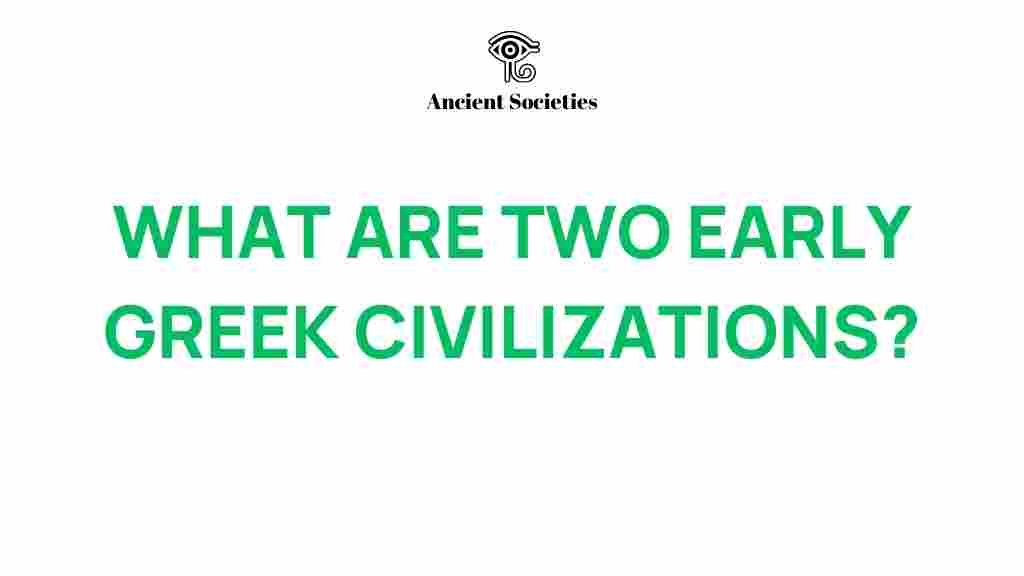Unveiling the Secrets of Two Early Greek Civilizations
The study of ancient history reveals a rich tapestry of societies that have shaped the modern world. Among these, the **Minoan** and **Mycenaean** civilizations stand out as two of the earliest Greek civilizations that laid the groundwork for future cultures in the Aegean region. This article delves deep into their archaeology, culture, society, historical impact, and legacy, uncovering the secrets that make these civilizations remarkable.
Introduction to Greek Civilizations
Greek civilizations have significantly influenced Western culture and thought. The Minoans and Mycenaeans, flourishing during the Aegean Bronze Age, represent the dawn of Greek history. Understanding their contributions gives insight into the evolution of **Greek culture**, societal structures, and the artistic expressions that followed.
The Minoan Civilization
The Minoan civilization, centered on the island of Crete, emerged around 3000 BCE and lasted until about 1450 BCE. Named after the legendary King Minos, this civilization is known for its advanced architecture, sophisticated art, and extensive trade networks.
1. Archaeological Discoveries
Archaeology has played a crucial role in unveiling the secrets of the Minoans. Key sites include:
- Knossos: The largest Bronze Age archaeological site, featuring a complex palace structure with elaborate frescoes.
- Festos: Known for its grand palace and the discovery of the Phaistos Disc, an enigmatic artifact.
- Akrotiri: A well-preserved Minoan town buried by volcanic ash, revealing insights into Minoan daily life.
2. Minoan Culture and Society
Minoan society was characterized by:
- Trade: Minoans engaged in extensive trade across the Mediterranean, influencing and being influenced by other cultures.
- Art: They produced stunning frescoes and pottery, often depicting nature and religious ceremonies.
- Religion: Minoans practiced a polytheistic religion, with a focus on goddess worship, as seen in their art and artifacts.
3. Historical Impact of the Minoans
The Minoan civilization had a profound impact on the subsequent cultures of the Aegean. Their innovations in architecture and art influenced the **Mycenaean civilization**, which emerged later. The Minoans laid the groundwork for trade networks that would be vital for future Greek city-states.
The Mycenaean Civilization
Following the decline of the Minoans around 1450 BCE, the Mycenaean civilization rose to prominence on the Greek mainland. This period is often referred to as the Late Bronze Age, marked by significant developments in culture and military prowess.
1. Archaeological Insights
Key archaeological sites provide insights into Mycenaean life:
- Mycenae: The site of the famous Lion Gate and elaborate burial tombs known as tholoi or beehive tombs.
- Tiryns: Renowned for its massive cyclopean walls and intricate palatial structures.
- Pylos: Home to a well-preserved palace and Linear B tablets, which are crucial for understanding Mycenaean administration and language.
2. Mycenaean Culture and Society
The Mycenaean civilization was marked by:
- Warrior Society: Mycenaeans were known for their militaristic culture, which emphasized strength and conquest.
- Linear B Script: This early form of Greek writing was used for administrative purposes and reflects the complexity of their society.
- Religion: Like the Minoans, they practiced polytheism, but their pantheon included more gods associated with warfare.
3. Historical Impact of the Mycenaeans
The Mycenaean civilization significantly shaped the later **Greek city-states**. Their collapse around 1100 BCE led to the Greek Dark Ages, but many aspects of their culture, such as language and religious practices, persisted and evolved into Classical Greece.
Comparative Analysis of Minoan and Mycenaean Civilizations
While both civilizations contributed to the tapestry of **Greek history**, they exhibited distinct characteristics:
- Architecture: Minoans focused on palatial complexes with elaborate frescoes, while Mycenaeans built fortified citadels.
- Artistic Expression: Minoan art was more naturalistic and vibrant, while Mycenaean art often depicted scenes of warfare.
- Societal Structure: Minoan society appeared more egalitarian, whereas Mycenaean society was hierarchical and militaristic.
Legacy of the Minoan and Mycenaean Civilizations
The legacies of these early **Greek civilizations** are profound:
- Influence on Classical Greece: Both civilizations set the stage for the cultural and political structures of later Greek city-states.
- Literature and Mythology: The tales of heroes and gods from Mycenaean culture influenced later Greek literature, including works by Homer.
- Archaeological Significance: Discoveries from both civilizations continue to inform our understanding of ancient history and archaeology.
Troubleshooting Tips for Exploring Minoan and Mycenaean Sites
If you’re planning to explore archaeological sites related to these early **Greek civilizations**, consider the following tips:
- Research: Before visiting, research the sites to understand their historical context and significance.
- Guided Tours: Consider joining guided tours for a more in-depth understanding of the culture and archaeology.
- Respect the Sites: Follow guidelines to preserve these ancient locations for future generations.
Conclusion
The Minoan and Mycenaean civilizations are integral to the story of **Greek civilizations**. Their archaeological remains, cultural achievements, and societal structures provide invaluable insights into ancient history. As we continue to explore and study their legacy, we uncover not only the secrets of the past but also the foundations of Western civilization.
For further reading on ancient Greek civilizations, you can visit this informative resource. Additionally, to dive deeper into archaeological findings, check out this site.
This article is in the category Archaeology and created by AncientSocieties Team

1 thought on “Unveiling the Secrets of Two Early Greek Civilizations”